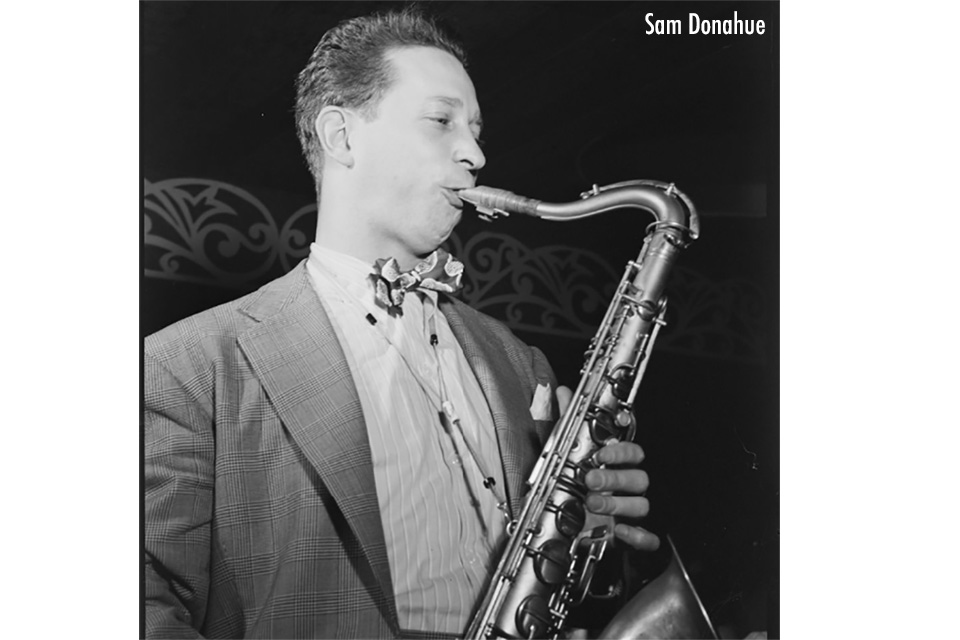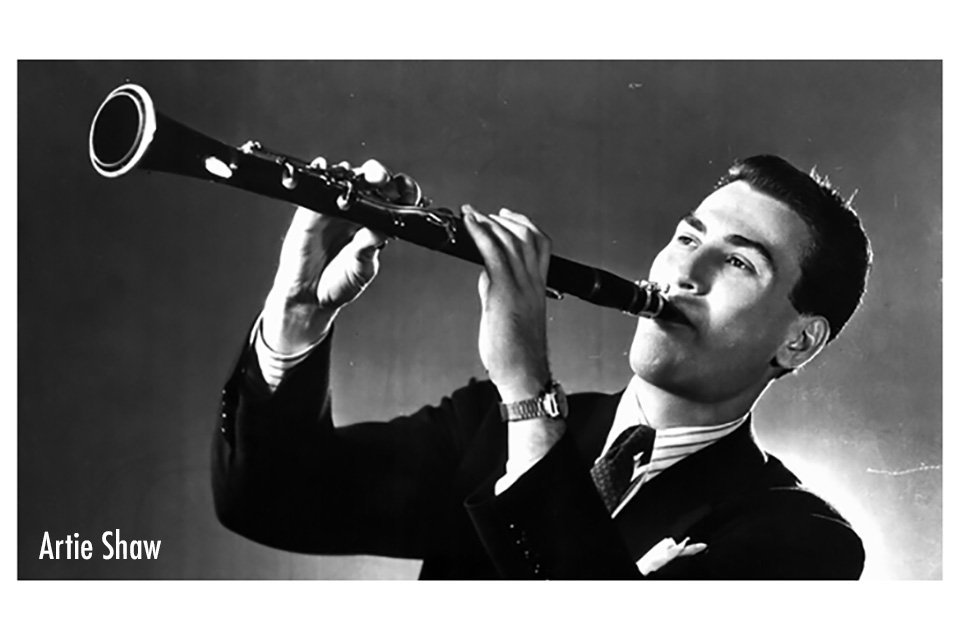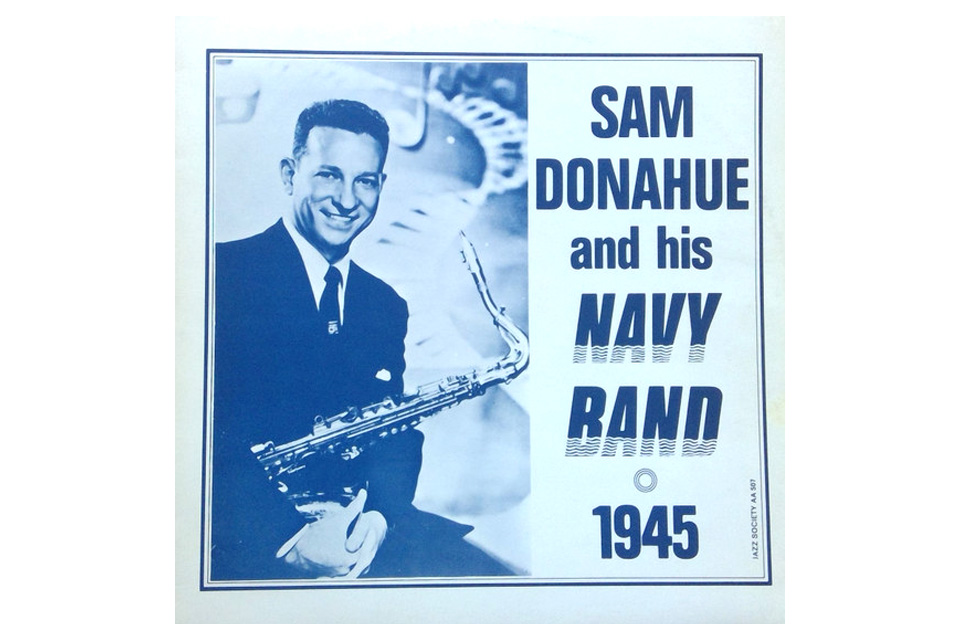Sam’s Liberation Band
20th January 2022“…he took over Artie Shaw’s band after the latter’s discharge and developed it into one of the most magnificent bands of all time.”
George T.Simon
Late in 1943 a twenty-five year-old musician went to Washington with a mission. The future of his band was uncertain. Maybe he could persuade the admirals his band should keep on playing. He was Sam Donahue and, fortunately, he was successful.

With Gene, Benny and Artie
Samuel Koontz Donahue was born in Detroit in March 1918. Before he was in his teens he was learning the clarinet and saxophone and by the time he was a teenager he was leading his own local band. In 1938 he became tenor saxophonist with the Gene Krupa Orchestra and started to write arrangements for the drumming star. Brief spells with the bands of Benny Goodman and Harry James followed and by now the young saxophonist had also become a competent trumpeter. At the time America joined the Second World War Donahue was back leading a band out of Detroit, but in October 1942 his bandleading career was put on hold; that was the month that Donahue enlisted in the U. S. Navy and became a Musician, Second Class.
He would soon join the band that Chief Petty Officer Artie Shaw was assembling. Known as Shaw’s Navy Band or Navy Reserve Band 501 or The Rangers, the musicians Shaw had brought together sailed for Pearl Harbour on Christmas Day 1942 and, thereafter, entertained troops on island bases, on battleships and on aircraft carriers in the South Pacific. Three of the band that later returned to America were breaking down and were ready for medical discharge. They were the band’s leader, Artie Shaw, drummer Dave Tough and trumpeter Max Kaminsky. The rest, who returned in October 1943, were given one month’s leave. It had been a draining and debilitating tour of duty. But the musicians who hadn’t been discharged, wanted to stick together with Donahue as their spokesperson and leader, and, after his successful visit to Washington, they began to plan for their musical future.

A “musician’s dream”
At some point a few new musicians were added to what had been Artie Shaw’s Navy Band, the arrangements the band had used were returned to Shaw, and, with himself and Dave Rose and Dick Jones as arrangers, Donahue began to change the band’s approach. Trombonist Tasso Harris summed up the new venture: “Sam…changed the band’s style into more of a Basie/Lunceford bag, with more hard swing and jazz…the band became a musician’s dream.”
Now known as ‘The Band of the U. S. Navy Liberation Forces under the direction of Sam Donahue’, in April 1944, the band crossed the Atlantic aboard a vessel that had the official title ‘Landing Craft, Tank’, the kind of boat designed to offload heavy military equipment on beaches. The crossing was described as “horrendous”. The band landed in Plymouth and then travelled to its base in Exeter, from where, as arranger Dave Rose later recollected, the band set off to play “at almost every base, depot, hospital or airfield where GIs were stationed”, and in the weeks before D-Day there were hundreds of thousands American troops stationed around Britain. The band also travelled to London and was broadcast by the BBC, often playing in concerts with other orchestras, like the RAF’s Squadronnaires and Captain Robert Farnon’s Canadian Band of the Allied Expeditionary Forces. In September 1944, at the Queensbury All-Services Club (formerly and later The Prince Edward Theatre), Donahue’s outfit appeared in a concert with Major Glenn Miller’s internationally renowned American Army Airforce Orchestra. The result was a victory for Donahue’s musicians. Bernie Privin, one of Miller’s trumpet stars, summed up the exchanges: “Yeah, they really cut us that night.” And Glenn knew it too. “That was some band.”
Over seventy years later, in 2017 to be exact, musicologist Lynn Rene Bayley came to a similar verdict as Privin and Miller: “the few times outsiders had a chance to hear it they were stunned and amazed. Here was a band that had power but didn’t hit you over the head like Stan Kenton; it had finesse like Jimmie Lunceford’s band but their arrangements weren’t “cute” or precious. They just played straight-ahead jazz charts that made little concession to popular tastes, featuring a trumpet section that was the envy of the band industry and a sax section that blended perfectly – all driven by a greased lightening rhythm section.” The trombones weren’t bad either.
Personnel and recordings
The musicians in the Liberation Forces Band were: tenor sax/trumpet and leader/arranger, Sam Donahue; lead alto sax, Mack Pierce, alto sax and clarinet, Ralph La Polla, alto sax, Bill Nichol, tenor sax, Joe Aglora, baritone sax, Charlie Wade; trumpets, Conrad Gozzo, Frank Beach, Don Jacoby, John Best; trombones, Tasso Harris (replaced by Owen Masingill in September 1945), Vahe ‘Tak’ Takvorian, Dick Le Fave, Gene Leech; piano, Rocky Coluccio; guitarist, Al Horish; bassist, Barney Spieler; drums, Buzz Sithens. When Donahue joined in on tenor, the band would have a six-piece saxophone section, with its three altos bringing their brightness to their section’s sound. When the leader joined the trumpets, the powerhouse section had power to spare.
And all the sections, including the rhythm section, had impressive soloists: Ralph La Polla was an excellent clarinettist and Joe Aglora on tenor had a warmer tone and more direct approach than his leader; amongst the trumpets, Conrad Gozzo and John Best are just two that deserve a mention, as does the soft and lyrical trombonist, Dick Le Fave; and pianist Rocky Coluccio could deliver with a Basie-like spareness, though he could also add harmonic richness whatever the sequence. As for the leader’s tenor, it was nimble and agile particularly in the upper register, often making many think they were listening to a quick-fingered alto player, and in the lower register, he could generate great excitement with his hoarse and slightly sultry sound.

A 1944 piece in the Melody Maker summed up the band as “an uninhibited powerhouse unit that makes few concessions to commercialism and moves along with a beat and attack that actually scare you” led by “a terrific tenor man, a unique arranger…who looks as if he belongs in front of a band.”
Unfortunately, as Bayley has pointed out, unlike Glenn Miller, “Donahue didn’t have a regular broadcast or V-Disc recording schedule” ( V-Discs, the ‘V’ stood for ‘Victory’, was a record label which ran between 1943 and 1949 to provide records for US military personnel). Yet, despite tours that included playing for American troops in Europe, around the Mediterranean and in North Africa, the band did manage to make some records; some were made in London in December 1944 and, after its return to America in March 1945, the band made some V-discs in New York. There were also some recordings made on America’s West Coast later in 1945, but for a band of its quality it has to be admitted that it was under-recorded.
My favourites among the recordings the band did make include David Rose’s arrangement of ‘Dinah’ from London in December 1944 and ‘My Melancholy Baby’, recorded in New York, both of which show an orchestra that, whatever its power, could play with considerable charm and delicacy. I would also add Sam Donahue’s composition and arrangement of ‘Convoy’, recorded in New York in June 1945, of which two takes are available, a composition that may bring to mind a Prokofiev piece that the Sauter-Finegan Orchestra had some success with in the 1950s. The completed version of Ellington’s ‘C Jam Blues’ (one version break’s down) from one of the June V-disc sessions would also be on my list together with ‘Moten Swing’, recorded, according to the information I have, the very next day (1). Though its recordings were few, several of the discs the Liberation Band made were near-masterpieces and deserve to be better known.
Into civvy street
There had been hopes that the band Donahue led might stay together after the war, but its musicians were discharged at different times, and those who were discharged found employment where they could. Some of the brass players went to Benny Goodman, some other players went to Les Brown and some returned to teaching. When Donahue himself was discharged he assembled a small group that included alto legend, Willie Smith, and recorded some septet sides for the Encore label. When he did assemble a big band, he still favoured the Liberation Orchestra’s line-up of a six-piece saxophone section, with three altos, or, if he turned to trumpet, he would use five trumpets, but the sound wasn’t the same (2).
Donahue was recalled to the Navy during the Korean War to help reform the Navy School of Music, and, after his discharge from the Navy Reserve, he worked with Tommy Dorsey, Stan Kenton and Harry James. For a while in the 1960s he was leader of the Tommy Dorsey ‘ghost’ band (Tommy having passed away a few years earlier), which toured extensively with Frank Sinatra, Jr. In his final years, Donahue was leading the house band at the Nugget Casino in Sparks, Nevada. He died from cancer in March 1974 aged fifty-six.
Sam Donahue spent most of his life as a professional musician and for most of that time he was leading a big band.
After leaving the Navy for the first time he had several recordings in the American charts, but he never became a household name, and many who remember him to-day, will not think of him as someone who made popular recordings. Instead, they will remember him leading and arranging for an astonishing group of musicians during the war years. In the main those musicians were assembled to be someone else’s band, and when they re-emerged, they were together for only a couple of years. A short time, a terrible time, but also a time when a group of bandsmen produced truly outstanding music. As Bayley puts it, “that 1944-45 Navy band was one of a kind.”
Peter Gardner
January 2022
Acknowledgement
I am most grateful to Sam Gregory, Dawkes’ woodwind specialist.
Endnotes
(1) All of the recordings I have mentioned from 1944-45 appear on these highly recommended CDs: ‘Sam Donahue directing The Band of the U.S. Navy Liberation Forces, Convoy , 1945’, Volume 1, HEP CD 2; and ‘Sam Donahue directing The Band of the U.S. Navy Liberation Forces, LST Party, 1945’, Volume 2, HEP CD 5. These recordings might also be available elsewhere.
2) A selection of Donahue’s recordings, including some with the Liberation Orchestra and some with Willie Smith, can be found on the double CD: ‘The Sam Donahue Collection, 1940-1948’, Acrobat Music, ADD CD 3370.
Some sources used
Lynne Rene Bayley, ‘Forgotten Jazz Orchestras: Sam Donahue’s Navy Band’, The Art Music Lounge, 2017.
Ian Crosby, insert notes for ‘Sam Donahue directing the band of the US Navy Liberation Forces, LST Party, 1945’, Volume 2, HEP CD 5.
Albert McCarthy, Big Band Jazz (Peerage Books, London, 1983).
Alastair Robertson, insert notes for ‘Sam Donahue directing the band of the US Navy Liberation Forces, Convoy , 1945’, Volume 1, HEP CD2.
Alastair Robertson, insert notes for ‘Sam Donahue and His Orchestra, Take Five, 1945-47’, HEP CD 71.
George T. Simon, The Big Bands, 4th Edition (Collier Macmillan, London, 1981).
Paul Watts, insert notes for ‘The Sam Donahue Collection, 1940 – 1948’, Acrobat Music 3370.